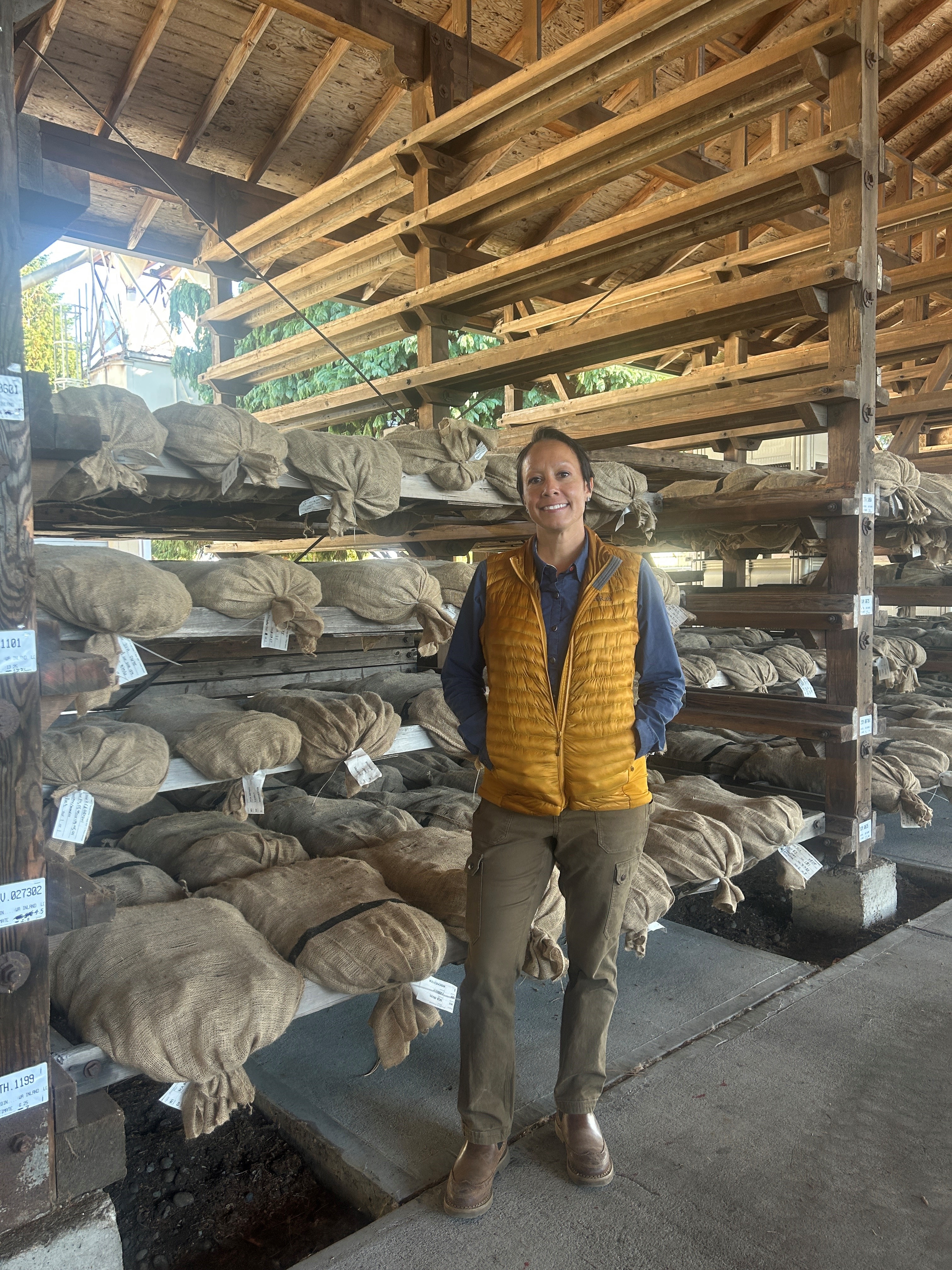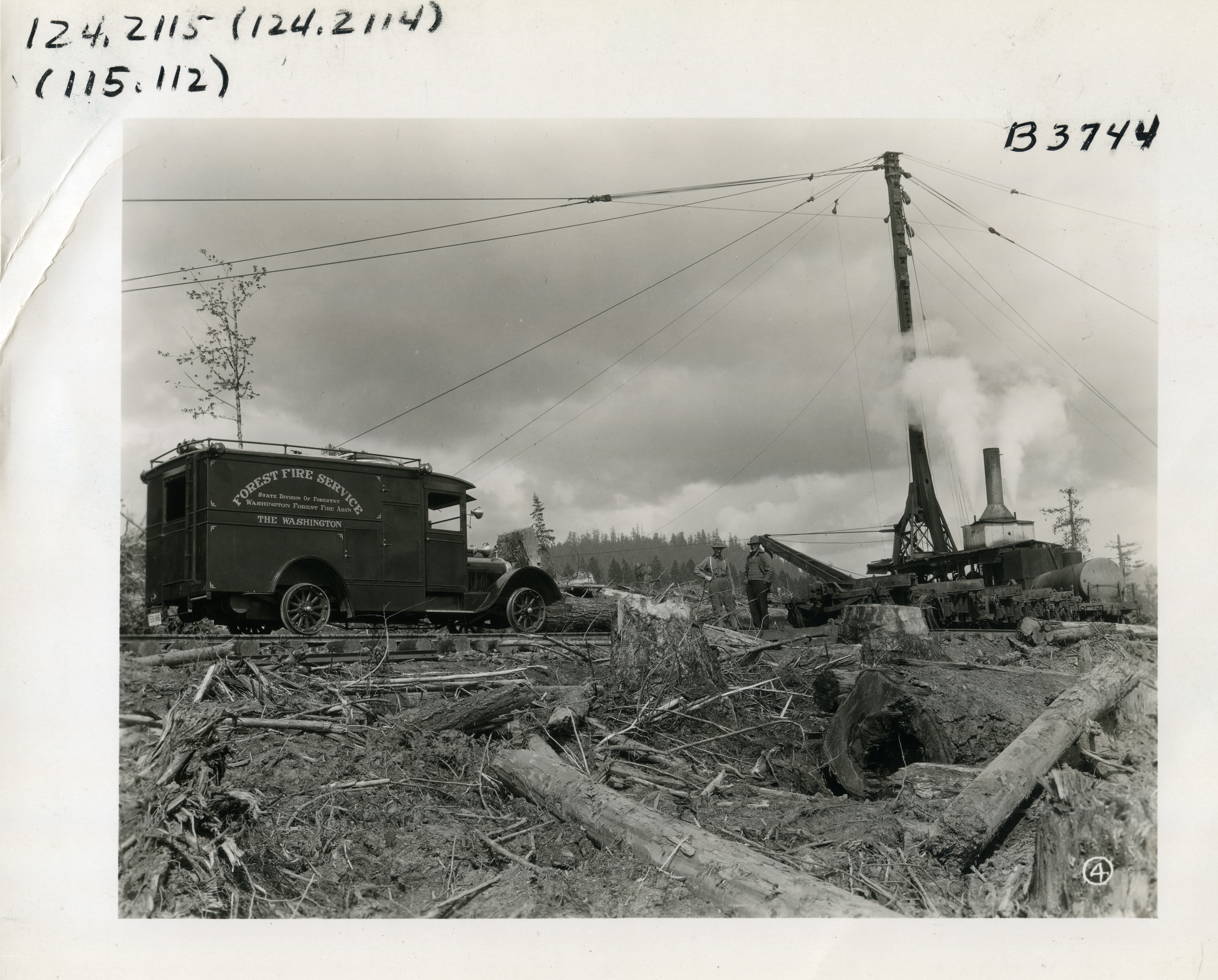
Viviana with bagged cones awaiting their turn through the seed plant.
On a sunny September afternoon at our nursery in Rochester, Washington, hundreds of burlap bags full of Douglas-fir cones rest on enormous, covered outdoor racks. At this stage, they are nearly ready to start their journey through the drying, sorting, counting and stratification processes necessary to prepare them for planting.
Viviana Olivares, seed plant manager, and her team will be there every step of the way.
“We process an average of 2,500 cone bushels — 1,200 pounds of seeds — per year here at Rochester, and all of them pass through my hands at some point,” Viviana says. “This is our only seed processing facility on the West Coast. It’s a lot of responsibility! All of our products, from seedlings to trees to wood products, start with the highest quality seeds we can provide.”
MEET VIVIANA
Your title is seed plant manager. Tell us what you do.
We have two main responsibilities: Maintaining a five-year seed inventory based on harvest trends for all of our Western Timberlands, and processing seed for growing contracts.
Let’s start with seed inventory. I receive shipments of cone bushels from our three seed orchards during the late summer months. We have various machines to extract and separate the seeds from the cones. We use advanced technologies, like our digital seed counter and X-ray machines, to count and inspect our processed seed for imperfections. At this point, the seed is ready for germination testing in our growth chambers. With those final results, we review our inventory replenishment strategies and short- and long-terms goals, all to utilize the best genetics to invest back into our timberlands.
Every step of the way my team protects the seeds’ parentage and genetics to maintain the desired qualities in the seedlings we intend to produce. We maintain a four- to five-year stock of seeds in a giant zero-degree freezer. This strategy is a proactive approach to be prepared for an emergency event that could significantly alter our typical seedling need, such as the 2020 Oregon wildfires. Thanks to our seed stock, we had a head start of seeds ready to go to help reforest our lands as quickly as possible.
Second, we process seed for growing contracts, which order by the pound of seed. There are about 36,000 Douglas-fir seeds to a pound. We withdraw seed and stratify it for our five internal nurseries in Western Timberlands. Seed stratification is a sped-up version of what they’d naturally experience in a Pacific Northwest winter, starting with a 24-hour oxygenated water bath. They’re drained and later surface-dried on trays in a large drying chamber with fans, and then go into our 32-degree cooler for a set period of time. This process mimics rainfall and winter temperatures in the natural process. They’ll stay refrigerated until the growers are ready for them, which typically starts in January and ends in May. (Viviana recently provided a tour of the seed plant for Seattle's KING 5 “Evening” TV program!)
Viviana and her daughter Mia at the 2022 Run for a Cure. At this point in her cancer treatment, Viviana had lost all her hair.
What led you to choose this job?
I was born and raised in El Paso, Texas, and spent a lot of time camping and hiking in New Mexico. That spurred me to get a degree in forestry. I thought I’d be a park ranger or an urban forester. Then I moved to Washington state, which opened up new opportunities.
I started my forestry career in Bellingham as a forest manager. After a move to the Olympia area, I got my first regeneration job at the Department of Natural Resources’ Webster Forest Nursery, and I fell in love with it. I found that I love growing plants and forestry. I spent six years as a technician at their bare root facility, then was promoted to the bare root manager for another eight years.
In 2019, I saw a Weyerhaeuser job post for a seed plant manager. I was ready for a change and wanted to grow my skills and learn more about the seed side of the business. It’s been an amazing experience so far.
Viviana, Mia and Joel at a RAGNAR race this past June. They fundraised for the Autism Society of Washington under the team name Autism Ohana.
Tell us what your average day is like.
Part of the magic of my job is its ever-changing seasonal nature, but it always involves seed care and seed inventory. Our busiest time of year is fall, when we process all the seeds to prep them for planting or sale. Throughout the rest of the year, I’m often auditing or restocking seeds, managing the financial aspects of seed sales and looking for ways to improve our processes.
When we’re processing seeds, our focus is on seed purity and germination rate — in other words, seeds that are healthy and viable. At the beginning of the seed cleaning process, purity is very low, at about 50 percent. Each machine in the processing room gets us to a finer and finer level of purity. We have machines that blow air, that use vacuums, and that have screens for separating. The seed is heavier than the debris, so it falls down into a collection chamber. Our goal is to reach a purity of 98 percent or better by the end of the seed cleaning process.
Recent improvements in technology have really boosted the quality of seeds we’re able to produce. We test for moisture content and germination rates to ensure our customers are getting the very best. For Douglas-fir, our goal is a germination rate of 92 percent or better. Every day, we’re driven to do our best, and it’s very gratifying to see the results of our hard work.
Viviana and her husband Joel were Girlfriend’s Run for a Cure ambassadors this year during Breast Cancer Awareness month.
What’s your favorite part of your job?
The challenges are actually my favorite part — there’s always a new puzzle to solve. Maybe a machine breaks down, or there are personnel changes, or we experience environmental impacts in the orchards. The individual challenges can be hard, but I love solving problems and the dynamic nature of my job. It keeps me engaged and actively learning.
Tell us something about your job that might surprise people.
The amount of work that goes into separating and processing seed. And also, the amount of care we put into our seed cleaning. It takes weeks of work in our facility to produce a finished product that meets our standards.
Our work is technical in nature, but we have to remember our product is a living, breathing thing. We don’t stock widgets and gizmos, we stock living seeds that have to produce a seedling. We have to remember to treat them as such. People are always surprised and impressed with the scale of work that goes into producing a single pound of seed.
What advice would you give people who want a job like yours?
I recommend getting higher education with a focus on natural sciences. A basic understanding of plant life and biology serves as a great foundation. Also, get some exposure and experience — internships and seasonal jobs are a great way to start. Jobs in horticulture, forestry and agriculture all lend themselves well to the experience and skills needed to be a seed processor.
An example of an X-ray of a seed sample. “If I didn’t have a career in forestry, I think I’d be in the criminal science field,” Viviana says. “I love laboratories and technology, which is part of what I enjoy about my job here.”
What are your career aspirations?
I’ve gained a lot of experience in the forestry and nursery sides of the business. Now, I’m hoping to become the person people come to when they need a seed expert. Every day I learn something new, and it inspires me to continue to be better at my job. Maybe someday that will lead to a higher-level role, or a job teaching others. I really enjoy sharing my knowledge and experience with others to help them grow professionally and get promoted.
Tell us about your other interests. What do you like to do when you’re not at work?
I love gardening and landscaping. I have a nice little urban garden full of containers at home. Growing vegetables and fruit for my family is extremely fulfilling for me. Caring for my landscape plants is fun, I love all of them. I’m very active and do a lot of hiking, strength workouts, running and half-marathons. Next year, I hope to complete my third triathlon!
Some of the screens inside the seed plant, which help separate the seed from organic debris in the cones.
My teenage daughter was diagnosed with autism at a very young age, so my husband Joel and I have been very active in autism awareness through the Autism Society of Washington. Last year, I was one of the weekly Giving Campaign winners, and Travis Keatley, senior vice president of Timberlands, donated $500 to the organization. We had such a great conversation about it, and he donated again this year! I love that Weyerhaeuser is such a generous organization.
For the past decade, Joel and I have participated in the Girlfriend’s Run for a Cure in Vancouver, Washington, which occurs every October during Breast Cancer Awareness Month. Last year, I was diagnosed with breast cancer myself. Since we’ve participated with the organization for a while, they made us ambassadors this year, which is an honor. Cancer has been very humbling for me, because I’m very independent and have needed a lot of help. It’s taught me a lot about myself and others. I appreciate and embrace this life lesson. On the other side of this, I will be a more patient, appreciative and understanding person.


